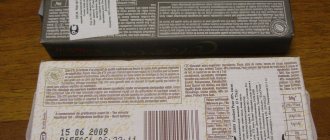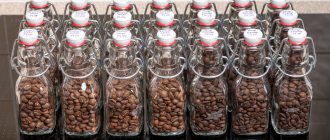Shelf life of coffee beans
How long they can be stored without deteriorating or losing their properties depends on the type. The shelf life of coffee beans, if they have not been roasted, is on average 1 year. This is most often indicated by the manufacturer directly on the packaging. If green beans have been processed properly, this period of time can increase to two or even two and a half years.
If the grains were packaged incorrectly, then the shelf life may, on the contrary, be greatly reduced. When purchasing, it is advisable to be able to evaluate the appearance of the grains. They should have a rich greenish tint, which indicates freshness. If the grains are pale, it means that they have been lying around for a long time and could lose their properties. It is also important to pay attention to the integrity of the packaging.
Roasted coffee beans retain their quality much worse. If you store it incorrectly, it will lose its taste and aroma in just a week. Roasted grains have one feature - they easily absorb moisture and foreign odors, which seriously affects their own properties. Therefore, the choice of packaging for their storage must be approached with special care.
In a paper bag, the shelf life is about two weeks; foil packaging allows you to preserve the quality of coffee beans for up to three months. The best type are special tightly closed containers in which coffee can be easily stored for six months.
How long do unroasted beans last?
Grains without heat treatment can retain their valuable qualities for 1-3 years , and the use of sealed packaging can extend storage up to 5 years.
The appearance of the grains also speaks volumes. Freshly picked fruits are distinguished by a rich green velvety color and a pronounced longitudinal stripe.
When broken, their edges remain smooth, and they are characterized by the smell of fresh grass.
The pallor of the grains indicates their age.
And if in one package there are grains of different sizes and shades , then there is a mixing of harvests from different years.
This negatively affects the duration of preservation of the consumer qualities of the product.
Read in this article what kind of packaging and under what conditions it is better to store churchkhela.
It is also worth refusing to purchase grains that have shriveled edges , are hard, like stone, or, on the contrary, easily crumble, and have a musty smell.
Duration of storage of ground grains
Most lovers of the aromatic invigorating drink prefer to purchase it in whole grains. This is due to the fact that it is very difficult to store it in crushed form; it quickly loses its properties. If you purchased ground coffee in vacuum packaging, then after opening it can be stored for no more than two weeks. The essential oils contained in it evaporate very quickly. The shelf life of ground coffee, if it was ground yourself, does not exceed three days.
You might be wondering: Can I drink coffee while breastfeeding?
Coffee lovers advise:
- Purchase exclusively whole grains and grind them in a coffee grinder immediately before preparing the drink.
- If you still decide to buy ground coffee, then you should not buy it for future use; it is better to opt for a small amount.
- It is best to store it in a tightly sealed container, as far as possible from any strong-smelling products.
- Avoid exposure to moisture and direct sunlight.
Storage rules
Before choosing the best way to store ground coffee at home, you need to take into account all the fundamental concepts that directly affect the requirements for how to properly store bean or ground coffee at home. The taste and aroma properties are due to kafeol. This constituent substance contains more than two hundred individual elements, which, when combined, create specific aromatic notes. If coffee is stored improperly, some parts will disappear, causing the fragrance to disappear.
This violation is associated with the negative impact of several factors:
- Air. With constant reaction with oxygen, esters evaporate - loss of taste and aroma.
- Sudden changes in temperature. Heat leads to loss of moisture and compaction of coffee beans - the brewed drink will have unstable foam.
- Bright light.
- Moisture. High levels of humidity in the storage area lead to mustiness and mold formation.
- Foreign odors.
The refrigerator meets all of the above points. That is why it is not recommended to store ground or bean coffee in the refrigerator as an ordinary product, and is even prohibited. The grains in the refrigerator not only absorb moisture, but also succumb to frost and not the most pleasant odors.
The effect of unsuitable coffee on a person’s physical condition
There is a myth that coffee beans cannot go bad, which means you can drink coffee that is 10 years old. Only this is not alcohol; aging does not play an important role here.
| type of product | Storage term | Shelf life (years) |
| Green grains | No more than 2 years | 5 years |
| Packaged roasted beans or ground | Up to 18 months | 2-3 years |
| Roasted fruits or ground coffee without packaging | No more than two weeks | 2-3 years |
| Coffee capsules | 1-2 years | 5 years |
| Soluble | Up to 2 years | Up to 2 years |
When coffee has become obsolete and someone is consuming it, it’s a good idea to think about the consequences:
- moldy grains cause gastrointestinal upset, nausea and a gag reflex;
- grains with the smell of rancid fat are dangerous for people with liver disease;
- expired instant coffee guarantees heartburn.
If you don’t want to end up in a hospital bed after drinking a drink, you should pay special attention to where you store your coffee.
Storage duration of instant drink
With this variety the situation is much simpler. The shelf life of instant coffee is usually 2 years. This is due to the fact that during production it is subjected to processing using high temperatures. At the same time, most of the essential oils contained in natural coffee simply disappear from the product.
They are being replaced by artificial analogues, which remain in the product longer. However, once opened, the packaging should be stored for no more than three weeks. During this time, the remaining natural substances disappear. You can extend this period by placing the coffee in a hermetically sealed container. In such packaging it can retain its properties for up to two months.
Where to store
Is it possible to store coffee in the refrigerator? If you want to drink coffee and smell meat, fish or whatever is there, you can. But if coffee sourness or bitterness has value, you still need to look at other options for placement. For example, a closed kitchen cabinet away from the stove. All the right conditions are here:
- correct temperature conditions;
- radiation protection;
- dry surface;
- low humidity.
The freezer is suitable for storing beans that have just been roasted. The quality will not deteriorate if all rules are carefully followed:
- Dense opaque packaging that does not allow moisture to pass through.
- Regular extraction of coffee is prohibited.
- The permissible period of stay does not exceed two months.
Experts in this case confirmed that this storage method extends the “life” of the grains. But this is not for “coffee for every occasion.”
Therefore, all gourmets and coffee lovers - forget about the refrigerator. The only storage arsenal is a separate kitchen cabinet and a vacuum bag. The right approach will ensure the preservation of all substances in the beans, which means delicious coffee at the end!
Different types of storage containers
There are several types of packaging in which coffee is usually kept:
- Paper bags;
- Containers made of plastic or metal;
- Foil packaging with check valve;
- Glass or ceramic containers with a tight-fitting lid.
Each type has its pros and cons, which are worth considering in more detail.
Coffee is most often sold in bags made of paper in stores. But this is not the best packaging for the product. It is quite thin and does not protect well from environmental influences. Therefore, after purchasing, when you come home, it is advisable to pour the coffee into another, more suitable container for storage.
Metal and plastic containers are separated into a single group, since both are poorly suited for storing coffee in them for a long time. The reason for this is that these materials tend to give the product an unpleasant aftertaste, and can themselves become saturated with its odor, which is difficult to remove.
You will be wondering: Is it possible to drink coffee at night and is it true that you won’t fall asleep later?
Very often glass or ceramic jars are used for this purpose. It is advisable that the lid be equipped with a silicone seal to ensure the tightness of the package. If the container is transparent, then it is advisable to place it in a dark place to prevent exposure to sunlight. The disadvantage of such containers is that there is no possibility of removing carbon dioxide from it.
Therefore, grains that have been roasted independently can be transferred to a jar only after a day. During this time, gases and excess moisture will come out of them.
The best storage option is foil bags equipped with a special clasp and valve. They significantly increase the shelf life of coffee. The opaque material prevents sunlight from reaching the product, and the non-return valve allows excess gas to escape freely from the packaging.
General rules for storing coffee
Finally, let's look in more detail at the general storage rules that apply to all types of coffee.
As mentioned above, coffee has a porous structure and absorbs odors and moisture from the air very well. Therefore, both roasted and raw beans, as well as ground coffee, must be stored with minimal air access and at a humidity of 50-60%.
Choose a dark place to store coffee, such as a cabinet with an opaque door.
Since oils and moisture begin to be released from coffee already at a temperature of +23 ℃, it should be kept away from the stove, oven and other very hot appliances.
The best container for storing coffee: any beans, ground and even instant - glass jars with screw caps or lids with a rubber layer for an airtight closure.
It is also possible to store grains in high-quality plastic containers suitable for storing bulk products. But you need to be prepared for the fact that some of the coffee aroma will be absorbed into the plastic. The container will have a coffee smell for a long time, and the quality of the bean will suffer.
Wooden and metal utensils are not suitable for storing coffee. In a metal one, the product will acquire the appropriate flavor, but in a wooden one, its aroma will simply fade away.
It is necessary to collect the raw materials for preparing the drink with a dry spoon. Even a small amount of moisture entering the jar can completely ruin the entire volume: the ground coffee will stick together in lumps and become moldy, and the coffee beans will also become moldy.
Scientists have long debated the benefits and harms of coffee. One thing remains indisputable: the unique taste and aroma of the drink have earned it love all over the world. To enjoy high-quality taste not only in coffee shops, but also at home, you should pay more attention to the storage process. Follow simple rules and pamper yourself with the bright tastes of various types of coffee. Let's store coffee correctly!
Can I drink coffee if the expiration date has expired?
Like any other product, it is better not to use it after the storage time has expired. Spoiled coffee can be identified by several signs:
- The appearance of rancid taste;
- Lack of aroma of the drink;
- The appearance of mold (this happens if moisture gets into the packaging);
- Formation of foreign odors.
What happens if you drink expired coffee? Even one cup of this drink can cause food poisoning. The main danger comes from the fats present in the grains, which seriously deteriorate over time. Instant coffee is unlikely to lead to dire consequences, since it does not contain such substances. But one way or another, you won’t get a tasty drink from a product that has expired.
If you hate to throw away expired coffee beans, you can use them to make crafts. They are often used to create topiaries, panels and decorate photo frames. Using imagination and creativity, you can make an interesting decoration for your interior.
Storing coffee beans
The main enemy of coffee is air. Roasted coffee beans are a delicate product. Many people value the degree of roasting, which directly affects the manifestation of certain taste and aroma qualities. Here's what happens when you store coffee beans outdoors:
- Coffee oils evaporate - a great value, giving the taste richness and a unique shade.
- The aroma is exhaled.
- Beans absorb moisture from the air and spoil.
- In addition to moisture, all foreign odors are absorbed. The quality of the aromatic product deteriorates greatly.
The drink prepared from such grains is very far from perfect. It can be called coffee, but, alas, it will irrevocably lose quality and will not bring pleasure.
Many people buy green beans for roasting themselves.
Coffee gourmets, having studied the rules of roasting beans themselves, prefer to buy green beans. This is the longest shelf-stable product. You can keep them in the refrigerator on the middle shelf, take out portions for frying and enjoy the perfection produced. However, the method requires time and a painstaking approach. More often they buy already roasted beans of the brand they like.
Vacuum packaging or the foil version prevents the entry of air, moisture, and sunlight. All quality parameters of coffee beans are preserved for almost a year, if you do not open the packaging. An opened pack can be stored for no more than 3 weeks in a dry and dark place at a cool temperature.
Glass jars with tight-fitting lids are perfect for storing roasted beans. They protect the porous structure of the grains from foreign aromas. Do not store packages of coffee beans next to other aromatic products: spices, vinegar, seasoning.
Self-roasted coffee beans are best used immediately. Or put it in jars with tight lids, remembering to ventilate every 2 days - the grains emit a special gas.
It is convenient to store roasted grains in such jars
How to store coffee beans
Many baristas and coffee shop owners are actively interested in the issue of storing coffee beans. Let's consider the most practical options.
Original packaging
Foil packages with a ziplock seal and an air valve are considered the best option for storing coffee. And there are several explanations for this:
Thanks to the foil packaging, the product does not absorb foreign odors, which is very important for preparing a high-quality, tasty drink. This packaging does not allow air to pass through. When coffee beans, especially if they are already crushed, come into contact with oxygen, the first ones begin to actively lose their aromatic properties
Therefore, vacuum packaging is an excellent option to preserve the native aroma of beans. In addition, the existing valve on the bag ensures complete removal of gases from fresh grains to the outside. The foil packaging can be easily twisted, removing excess oxygen from it and thereby minimizing the oxidation of essential oils inside the beans, which give the finished drink its characteristic coffee taste and aroma. Another advantage of foil packaging is that it protects the product from light and moisture. The latter, in turn, significantly reduce the shelf life of the grains, giving them a characteristic bitterness.
Banks
A less preferred, but quite acceptable way to ensure satisfactory storage conditions for coffee beans. The most suitable options are ceramic and glass jars
It is very important that the lids seal the container tightly, preventing oxygen and moisture from penetrating inside. And given that beans do not like light, it is advisable to use opaque containers
In turn, such containers have several disadvantages:
- It is advisable to pour the product out of its original packaging 3-5 days after frying. During this time, the gases inside the beans will be able to freely exit them. In the jar, the gases will no longer be fully released.
- When coffee is poured from packaging into a jar, the beans are already saturated with a certain amount of oxygen. Not to mention the fact that it is not possible to rid the container of excess air. This means that inside the container the process of oxidation of their structure will begin to occur in the grains, which will negatively affect the taste and aroma of the beans and the finished drink. This is where the unpleasant sourness in coffee comes from.
Containers made of plastic and metal
The most preferred way to store coffee beans. Such containers give the beans an unpleasant odor, giving them an extraneous taste of plastic and iron.











